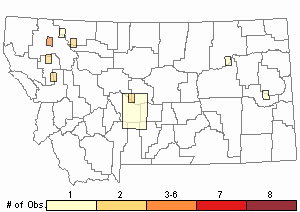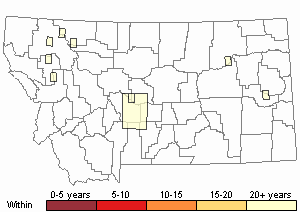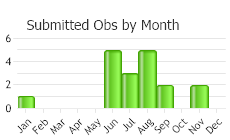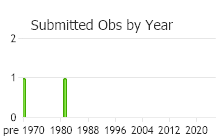View in other NatureServe Network Field Guides
NatureServe
Montana
Utah
Wyoming
Idaho
Wisconsin
British Columbia
South Carolina
Yukon
California
New York
Bog Broom Moss - Dicranum undulatum
General Description
Plants: Acrocarpous (Vitt 1988). Growing in crowded clumps of erect shoots, green to ochre, usually glossy. Stems 3-17 cm tall; rhizoids russet, covering the stem in thick woolly matting (FNA 2007).
Leaves: Straight (Lawton 1971) or slightly curved and twisted when dry, upright and overlapping or a little curved (sickle-like) when moist, the leaf tip frequently screwed, faintly to conspicuously wavy crosswise, cupped below, keeled distally, lance-shaped to slightly oblong to a mostly widely-acute apex, sometimes narrowly so, mostly 5-7.5 mm in length, occasionally to 11 mm, 0.7-1.2 mm in width; margins flat or sometimes tightly rolled up and inward at the base or widely curved back and downward above, saw-toothed or finely so from mid-leaf to the tip; nerve not reaching the apex although sometimes close, occasionally finely-toothed above on the dorsal surface (FNA 2007).
Leaf Cells: Lamina 1-layered, occasionally with regions of 2 cell-layers, the cell walls between cells protruding slightly to conspicuously both dorsally and ventrally; cells close to the leaf tip sometimes with papillae on the dorsal surface; upper laminal cells oddly angled or short and quadrangular, nonporose; middle cells porose; lower laminal cells somewhat long (FNA 2007) and thin (Lawton 1971), porose, and thick-walled; alar cells distinct, inflated, not reaching the nerve, the alar region 2 cell-layers thick; nerve with guide cells in 1 row, ventral and stereid bands reaching the apex, the ventral superficial layer of cells not distinct from adjacent stereids, and the dorsal superficial layer of cells differentiated (FNA 2007).
Phenology
Fruit ripens in spring (FNA 2007).
Diagnostic Characteristics
Dicranum polysetum differs from D. undulatum in having 2 ridges of teeth on the costa’s dorsal surface rather than none. D. polysetum also is more characteristic of upland, northern coniferous forests of the mountains (Vitt 1988), occasionally bogs (Lawton 1971), whereas D. undulatum is found more often in organic soils of fens and bogs (Vitt 1988).
Range Comments
North American Range
AK to NL and NS, WA, CA, MT, SD, MN to MI, IN and states east and northeast, also NC (FNA 2007). Known in Montana from Flathead, Glacier, Judith Basin, Lake, Meagher, and Valley Counties (Elliott 2016).
Observations in Montana Natural Heritage Program Database
Number of Observations: 18
(Click on the following maps and charts to see full sized version)
Map Help and Descriptions
Relative Density

Recency


 (Observations spanning multiple months or years are excluded from time charts)
(Observations spanning multiple months or years are excluded from time charts)
Habitat
Organic soil in bogs and fens (Elliott 2016), edges of lakes, occasionally on stones, bluffs, organic soils and decaying wood in damp woodlands (FNA 2007).
Reproductive Characteristics
Small males growing on female plant rhizoids. Inner perichaetial bracts enveloping the stem, suddenly narrowing to the acumen. Seta single, 20-40 mm tall. Capsule bowed and tilted, grooved when dry, shrunken below the opening, somewhat ochre to russet, 2-2.8 mm in length; peristome of 16 teeth, separated ca halfway down into 2 lobes (seldom 3), russet, with papillae above. Calyptra hood-like, hairless, sheltering much of the capsule, falling away easily (FNA 2007).
Stewardship Responsibility
References
- Literature Cited AboveLegend:
 View Online Publication
View Online Publication Elliott, J.C. and A.K. Pipp. 2018. A Checklist of Montana Mosses (1880-2018). Updated 3 January, 2020. Montana Natural Heritage Program, Helena, Montana. 73 pp.
Elliott, J.C. and A.K. Pipp. 2018. A Checklist of Montana Mosses (1880-2018). Updated 3 January, 2020. Montana Natural Heritage Program, Helena, Montana. 73 pp. Flora of North America Editorial Committee, eds. 2007. Flora of North America North of Mexico. Volume 27. Bryophytes: Mosses, Part 1. Oxford University Press, Inc., NY. xxi + 713 pp.
Flora of North America Editorial Committee, eds. 2007. Flora of North America North of Mexico. Volume 27. Bryophytes: Mosses, Part 1. Oxford University Press, Inc., NY. xxi + 713 pp. Lawton, E. 1971. Moss Flora of the Pacific Northwest. Hattori Botanical Laboratory. Japan: Yamabuki-cho, Shinjuku-ku, Tokyo. 362 pages plus appendices.
Lawton, E. 1971. Moss Flora of the Pacific Northwest. Hattori Botanical Laboratory. Japan: Yamabuki-cho, Shinjuku-ku, Tokyo. 362 pages plus appendices. Vitt, D. J. Marsh, and R. Bovey. 1988. Mosses, Lichens & Ferns of Northwest North America. Seattle, WA: University of Washington Press. 296 p.
Vitt, D. J. Marsh, and R. Bovey. 1988. Mosses, Lichens & Ferns of Northwest North America. Seattle, WA: University of Washington Press. 296 p.
- Additional ReferencesLegend:
 View Online Publication
View Online Publication
Do you know of a citation we're missing? Crum, H.A. and L.E. Anderson. 1981. Mosses of Eastern North America. 2 volumes. Columbia University Press, New York. 1328 pp.
Crum, H.A. and L.E. Anderson. 1981. Mosses of Eastern North America. 2 volumes. Columbia University Press, New York. 1328 pp. Elliot, J. C. 1993. Second checklist of Montana mosses. Unpublished report. U.S. Forest Service, Region 1. Missoula, MT. 45 pp.
Elliot, J. C. 1993. Second checklist of Montana mosses. Unpublished report. U.S. Forest Service, Region 1. Missoula, MT. 45 pp. Lawton, E. 1971. Keys for the Identification of the Mosses on the Pacific Northwest. Reprinted from 'Moss Flora of the Pacific Northwest'. Published as Supplement No. 2 of the Journal of the Hattori Botanical Laboratory. Nichinan, Miyazaki, Japan. 66 pp.
Lawton, E. 1971. Keys for the Identification of the Mosses on the Pacific Northwest. Reprinted from 'Moss Flora of the Pacific Northwest'. Published as Supplement No. 2 of the Journal of the Hattori Botanical Laboratory. Nichinan, Miyazaki, Japan. 66 pp. Malcolm, B., N. Malcolm, J. Shevock, and D. Norris. 2009. California Mosses. Nelson, New Zealand: Micro-Optics Press. 430 pp.
Malcolm, B., N. Malcolm, J. Shevock, and D. Norris. 2009. California Mosses. Nelson, New Zealand: Micro-Optics Press. 430 pp. Smith, A.J.E. 1980. The Moss Flora of Britain and Ireland. Cambridge University Press, Cambridge. 705 pp.
Smith, A.J.E. 1980. The Moss Flora of Britain and Ireland. Cambridge University Press, Cambridge. 705 pp.
- Web Search Engines for Articles on "Bog Broom Moss"





